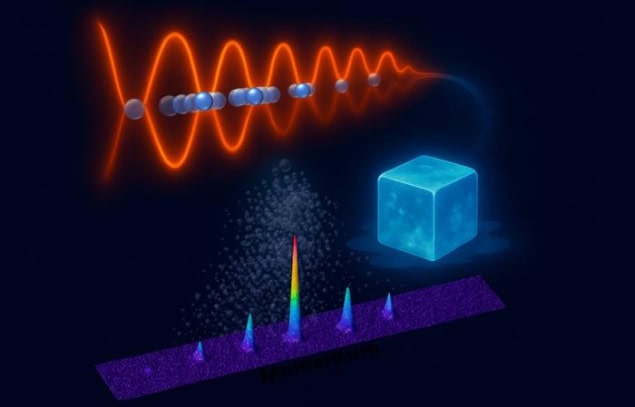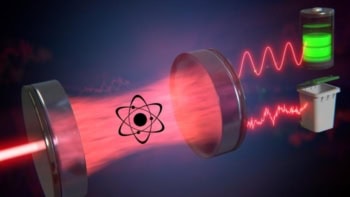
Adding energy to a system usually heats it up, but physicists at the University of Innsbruck in Austria have now discovered a scenario in which this is not the case. Their new platform – a one-dimensional fluid of strongly interacting atoms cooled to just a few nanokelvin above absolute zero and periodically “kicked” using an external force – could be used to study how objects transition from being quantum and ordered to classical and chaotic.
Our everyday world is chaotic and chaos plays a crucial and often useful role in many areas of science – from nonlinear complex systems in mathematics, physics and biology to ecology, meteorology and economics. How a system evolves depends on its initial conditions, but this evolution is, by nature, inherently unpredictable.
While we know how chaos emerges in classical systems, how it does so in quantum materials is still little understood. When this happens, the quantum system reverts to being a classical one.
The quantum kicked rotor
Researchers have traditionally studied chaotic behaviour in driven systems – that is, rotating objects periodically kicked by an external force. The quantum version of these is the quantum kicked rotor (QKR). Here, quantum coherence effects can prevent the system from absorbing external energy, meaning that, in contrast to its classical counterpart, it doesn’t heat up – even if a lot of energy is applied. This “dynamical localization” effect has already been seen in dilute ultracold atomic gases.
The QKR is a highly idealized single-particle model system, explains study lead Hanns-Christoph Nägerl. However, real-world systems contain many particles that interact with each other – something that can destroy dynamical localization. Recent theoretical work has suggested that this localization may persist in some types of interacting, even strongly interacting, many-body quantum systems – for example, in 1D bosonic gases.
In the new work, Nägerl and colleagues made a QKR by subjecting samples of ultracold caesium (Cs) atoms to periodic kicks by means of a “flashed-on lattice potential”. They did this by loading a Bose–Einstein condensate of these atoms into an array of narrow 1D tubes created by a 2D optical lattice formed by laser beams propagating in the x–y plane at right angles to each other. They then increased the power of the beams to heat up the Cs atoms.
Many-body dynamical localization
The researchers expected the atoms to collectively absorb energy over the course of the experiment. Instead, when they recorded how their momentum distribution evolved, they found that it actually stopped spreading and that the system’s energy reached a plateau. “Despite being continually kicked and strongly interacting, it no longer absorbed energy,” says Nägerl. “We say that it had localized in momentum space – a phenomenon known as many-body dynamical localization (MBDL).”
In this state, quantum coherence and many-body interactions prevent the system from heating up, he adds. “The momentum distribution essentially freezes and retains whatever structure it has.”
Nägerl and colleagues repeated the experiment by varying the interaction between the atoms – from zero (non-interacting) to strongly interacting. They found that the system always localizes.
Quantum coherence is crucial for preventing thermalization
“We had already found localization for our interacting QKR in earlier work and set out to reproduce these results in this new study,” Nägerl tells Physics World. “We had not previously realised the significance of our findings and thought that perhaps we were doing something wrong, which turned out not to be the case.”
The MBDL is fragile, however – something the researchers proved by introducing randomness into the laser pulses. A small amount of disorder is enough the destroy the localization effect and restore diffusion, explains Nägerl: the momentum distribution smears out and the kinetic energy of the system rises sharply, meaning that it is absorbing energy.
“This test highlights that quantum coherence is crucial for preventing thermalization in such driven many-body systems,” he says.
Simulating such a system on classical computers is only possible for two or three particles, but the one studied in this work, reported in Science, contains 20 or more. “Our new experiments now provide precious data to which we can compare the QKR model system, which is a paradigmatic one in quantum physics,” adds Nägerl.

The quantum Zeno effect: how the ‘measurement problem’ went from philosophers’ paradox to physicists’ toolbox
Looking ahead, the researchers say they would now like to find out how stable MBDL is to various external perturbations. “In our present work, we report on MBDL in 1D, but would it happen in a 2D or a 3D system?” asks Nägerl. “I would like to do an experiment in which we have a 1D + 1D situation, that is, where the 1D is allowed to communicate with just one neighbouring 1D system (via tunnelling; by lowering the barrier to this system in a controlled way).”
Another way of perturbing the system would be to add a local defect – for example a bump in the potential of a different atom, he says. “Generally speaking, we would like to measure the ‘phase diagram’ for MBDL, where the axes of the graph would quantify the strength of the various perturbations we apply.”



